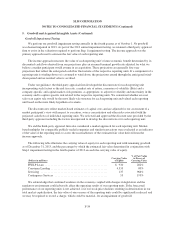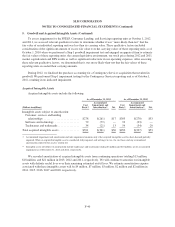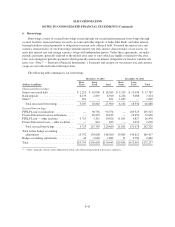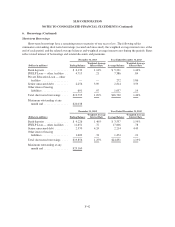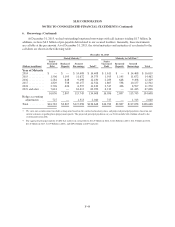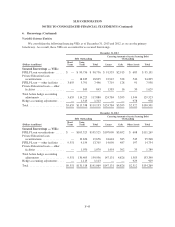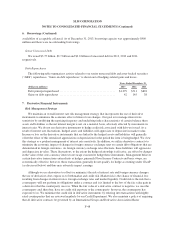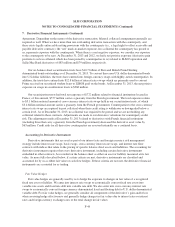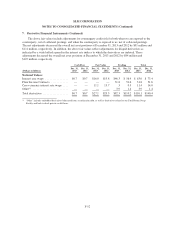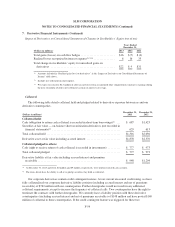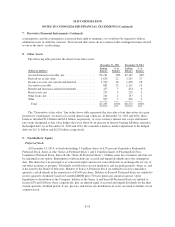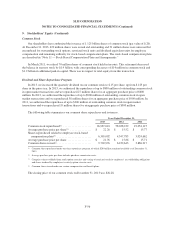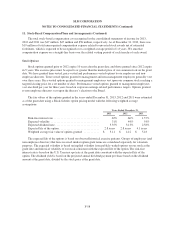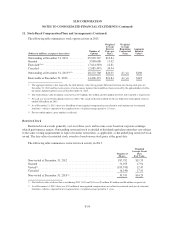Sallie Mae 2013 Annual Report Download - page 187
Download and view the complete annual report
Please find page 187 of the 2013 Sallie Mae annual report below. You can navigate through the pages in the report by either clicking on the pages listed below, or by using the keyword search tool below to find specific information within the annual report.SLM CORPORATION
NOTES TO CONSOLIDATED FINANCIAL STATEMENTS (Continued)
7. Derivative Financial Instruments (Continued)
Agreement. Depending on the nature of the derivative transaction, bilateral collateral arrangements generally are
required as well. When we have more than one outstanding derivative transaction with the counterparty, and
there exists legally enforceable netting provisions with the counterparty (i.e., a legal right to offset receivable and
payable derivative contracts), the “net” mark-to-market exposure, less collateral the counterparty has posted to
us, represents exposure with the counterparty. When there is a net negative exposure, we consider our exposure
to the counterparty to be zero. At December 31, 2013 and 2012, we had a net positive exposure (derivative gain
positions to us less collateral which has been posted by counterparties to us) related to SLM Corporation and
Sallie Mae Bank derivatives of $83 million and $79 million, respectively.
Our on-balance sheet securitization trusts have $10.7 billion of Euro and British Pound Sterling
denominated bonds outstanding as of December 31, 2013. To convert these non-U.S. dollar denominated bonds
into U.S dollar liabilities, the trusts have entered into foreign-currency swaps with highly–rated counterparties. In
addition, the trusts have entered into $12.8 billion of interest rates swaps which are primarily used to convert
Prime received on securitized student loans to LIBOR paid on the bonds. At December 31, 2013, the net positive
exposure on swaps in securitization trusts is $968 million.
Our securitization trusts had total net exposure of $772 million related to financial institutions located in
France; of this amount, $577 million carries a guaranty from the French government. The total exposure relates
to $5.1 billion notional amount of cross-currency interest rate swaps held in our securitization trusts, of which
$3.4 billion notional amount carries a guaranty from the French government. Counterparties to the cross currency
interest rate swaps are required to post collateral when their credit rating is withdrawn or downgraded below a
certain level. As of December 31, 2013, no collateral was required to be posted and we are not holding any
collateral related to these contracts. Adjustments are made to our derivative valuations for counterparty credit
risk. The adjustments made at December 31, 2013 related to derivatives with French financial institutions
(including those that carry a guaranty from the French government) decreased the derivative asset value by
$63 million. Credit risks for all derivative counterparties are assessed internally on a continual basis.
Accounting for Derivative Instruments
Derivative instruments that are used as part of our interest rate and foreign currency risk management
strategy include interest rate swaps, basis swaps, cross-currency interest rate swaps, and interest rate floor
contracts with indices that relate to the pricing of specific balance sheet assets and liabilities. The accounting for
derivative instruments requires that every derivative instrument, including certain derivative instruments
embedded in other contracts, be recorded on the balance sheet as either an asset or liability measured at its fair
value. As more fully described below, if certain criteria are met, derivative instruments are classified and
accounted for by us as either fair value or cash flow hedges. If these criteria are not met, the derivative financial
instruments are accounted for as trading.
Fair Value Hedges
Fair value hedges are generally used by us to hedge the exposure to changes in fair value of a recognized
fixed rate asset or liability. We enter into interest rate swaps to economically convert fixed rate assets into
variable rate assets and fixed rate debt into variable rate debt. We also enter into cross-currency interest rate
swaps to economically convert foreign currency denominated fixed and floating debt to U.S. dollar denominated
variable debt. For fair value hedges, we generally consider all components of the derivative’s gain and/or loss
when assessing hedge effectiveness and generally hedge changes in fair values due to interest rates or interest
rates and foreign currency exchange rates or the total change in fair values.
F-49


